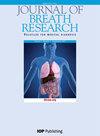出版者注:"重新审视强制掩蔽的理由"(2023J. 呼吸研究 4 042001)。
IF 3.7
4区 医学
Q1 BIOCHEMICAL RESEARCH METHODS
引用次数: 0
摘要
本文章由计算机程序翻译,如有差异,请以英文原文为准。
Publisher's Note: 'Revisiting the Rationale of Mandatory Masking' (2023J. Breath Res. 4 042001).
求助全文
通过发布文献求助,成功后即可免费获取论文全文。
去求助
来源期刊

Journal of breath research
BIOCHEMICAL RESEARCH METHODS-RESPIRATORY SYSTEM
CiteScore
7.60
自引率
21.10%
发文量
49
审稿时长
>12 weeks
期刊介绍:
Journal of Breath Research is dedicated to all aspects of scientific breath research. The traditional focus is on analysis of volatile compounds and aerosols in exhaled breath for the investigation of exogenous exposures, metabolism, toxicology, health status and the diagnosis of disease and breath odours. The journal also welcomes other breath-related topics.
Typical areas of interest include:
Big laboratory instrumentation: describing new state-of-the-art analytical instrumentation capable of performing high-resolution discovery and targeted breath research; exploiting complex technologies drawn from other areas of biochemistry and genetics for breath research.
Engineering solutions: developing new breath sampling technologies for condensate and aerosols, for chemical and optical sensors, for extraction and sample preparation methods, for automation and standardization, and for multiplex analyses to preserve the breath matrix and facilitating analytical throughput. Measure exhaled constituents (e.g. CO2, acetone, isoprene) as markers of human presence or mitigate such contaminants in enclosed environments.
Human and animal in vivo studies: decoding the ''breath exposome'', implementing exposure and intervention studies, performing cross-sectional and case-control research, assaying immune and inflammatory response, and testing mammalian host response to infections and exogenous exposures to develop information directly applicable to systems biology. Studying inhalation toxicology; inhaled breath as a source of internal dose; resultant blood, breath and urinary biomarkers linked to inhalation pathway.
Cellular and molecular level in vitro studies.
Clinical, pharmacological and forensic applications.
Mathematical, statistical and graphical data interpretation.
 求助内容:
求助内容: 应助结果提醒方式:
应助结果提醒方式:


